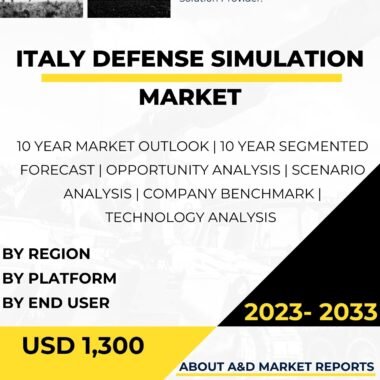Description
The defense simulation market in Japan has experienced significant growth and strategic importance in recent years, driven by the nation’s focus on enhancing its defense capabilities and addressing security challenges in the Indo-Pacific region. Defense simulations play a crucial role in military training, planning, and decision-making, offering a cost-effective and safe means to prepare military personnel for complex and dynamic operational scenarios.
As Japan faces evolving global security threats and regional tensions, the demand for advanced defense simulation technologies has grown. These simulations provide realistic and immersive training experiences for military personnel, enabling them to develop and hone their skills in a controlled environment.
The Japan Self-Defense Forces (JSDF) extensively uses defense simulations across various branches, including the Ground Self-Defense Force (GSDF), Maritime Self-Defense Force (MSDF), and Air Self-Defense Force (ASDF). These simulations cater to different aspects of military training, ranging from individual soldier training to large-scale joint exercises involving multiple military units.
One of the primary applications of defense simulations in Japan is individual soldier training. Virtual reality (VR) and augmented reality (AR) simulations allow soldiers to experience realistic combat scenarios, enhancing their tactical skills and decision-making capabilities.
Moreover, defense simulations are also utilized for collective training, involving groups of soldiers and units working together to achieve mission objectives. These simulations simulate complex military operations, such as urban warfare, amphibious assaults, and air-to-air combat, allowing military personnel to practice coordinated actions and communication.
In addition to training applications, defense simulations play a crucial role in mission planning and analysis. Military planners use simulations to evaluate the effectiveness of different operational strategies, assess the impact of various factors, and identify potential risks and vulnerabilities.
Furthermore, simulations are also used in research and development (R&D) to evaluate the performance of new defense technologies and systems. Modeling and simulation enable engineers and scientists to test prototypes and conduct virtual experiments, reducing the need for costly and time-consuming physical tests.
As Japan focuses on indigenous defense capabilities, the domestic production and development of defense simulation technologies have grown substantially. Collaborations between the government, defense industry, and research institutions have fostered innovation, leading to the creation of advanced simulation solutions tailored to Japan’s specific defense requirements.
Additionally, Japan’s alliance with the United States has facilitated access to advanced simulation technologies and expertise. This collaboration strengthens Japan’s defense capabilities and contributes to regional security and stability.
The defense simulation market in Japan also benefits from advancements in commercial gaming and virtual reality technologies. Many features from commercial gaming and entertainment applications, such as realistic graphics and user interfaces, have found applications in defense simulations, leading to increased realism and engagement.
However, the defense simulation market in Japan faces challenges related to cost considerations, interoperability, and data security. Developing and maintaining advanced defense simulations can be expensive, requiring careful budget allocation and prioritization.
Ensuring seamless interoperability between different simulation systems and military platforms is crucial for effective joint training and exercises involving multiple branches of the JSDF.
Moreover, safeguarding sensitive data and maintaining data security is paramount for defense simulations, as they involve the use of classified information and operational scenarios.
Another challenge is the need for a skilled and trained workforce to design, operate, and analyze defense simulations. Japan’s defense industry must invest in training and development programs to equip personnel with the necessary expertise and knowledge to conduct effective simulation-based training and analysis.
In conclusion, the defense simulation market in Japan has witnessed significant growth and strategic importance, driven by the nation’s focus on enhancing its defense capabilities and addressing security challenges in the Indo-Pacific region. Defense simulations play a critical role in military training, planning, and decision-making, providing realistic and immersive experiences for military personnel to develop their skills and enhance operational readiness. The collaboration between the government, defense industry, and research institutions, as well as international partnerships with allied nations, fosters innovation and contributes to the growth of the domestic defense simulation market. Challenges related to cost considerations, interoperability, data security, and workforce development must be addressed to further enhance Japan’s defense capabilities and ensure its ability to maintain a reliable and high-performance defense force, contributing to the modernization and effectiveness of the Japan Self-Defense Forces. With its strategic focus on modernizing its defense forces, Japan remains committed to leveraging advanced defense simulation technologies to enhance its defense capabilities and contribute to regional and global security.




